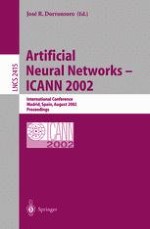The International Conferences on Arti?cial Neural Networks, ICANN, have been held annually since 1991 and over the years have become the major European meeting in neural networks. This proceedings volume contains all the papers presented at ICANN 2002, the 12th ICANN conference, held in August 28– 30, 2002 at the Escuela T´ecnica Superior de Inform´atica of the Universidad Aut´onoma de Madrid and organized by its Neural Networks group. ICANN 2002 received a very high number of contributions, more than 450. Almost all papers were revised by three independent reviewers, selected among the more than 240 serving at this year’s ICANN, and 221 papers were ?nally selected for publication in these proceedings (due to space considerations, quite a few good contributions had to be left out). I would like to thank the Program Committee and all the reviewers for the great collective e?ort and for helping us to have a high quality conference.
